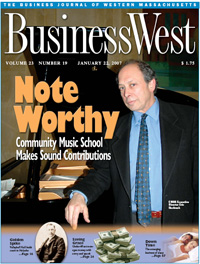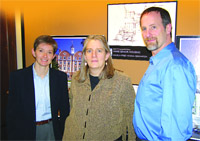The how and the why are often hard to peg, but Mass MoCA has spurred a rebirth in North Adams that is undeniable, if not always quantifiable. The fact of the matter is that, after years of economic strife and waning confidence, the old mill town in the Berkshires is entering a new age through the power of new art.
Mayor John Barrett III has led North Adams, the Commonwealth’s smallest city, for 23 years, and he knows the drill: when any community begins to show signs of new life, people want to see the proof of how and why in black and white.
And when it comes to arts and culture as an economic driver, the trend nationwide is to essentially prove a cultural venture’s worth through exhaustive studies, charting new dollars that a given entity brings into a community.
Those dollars are measured and classified in myriad ways, placed into columns with titles like ‘direct,’ ‘indirect, and ‘induced.’ Taxes are scrutinized, new business catalogued, housing trends tracked, and numbers of visitors tallied, all in the name of bringing some weight to the notion of art as a tool for struggling communities.
Barrett says he’s seen it all, and he doesn’t need those stacks of reports that typically cover his desk.
“The attention is wonderful, but I don’t need studies to tell me what’s happening here is working,” he said. “You can see it in the people. They’re … happy.”
What’s happening in North Adams is a ongoing rebirth, brought on primarily by the creation and building success of its cultural juggernaut, the Massachusetts Museum of Contemporary Art, most often referred to as Mass MoCA.
The museum, dedicated to contemporary art in all its forms – visual, music, dance, and film among them – opened its doors to the public in 1999, a decade after the state Legislature announced its support for the project. The economic health of the Commonwealth, or lack thereof, during that decade threatened Mass MoCA’s creation more than once, and community-based and private-sector contributions totaling more than $15 million for construction and programming were integral to the ambitious development plan that amounted to $31.4 million (state grants took care of the rest).
Today, Mass MoCA is the largest center for contemporary visual and performance art in the country, including about 600,000-square-feet of developable space and providing office and loft space for a number of diverse businesses on its campus as well. Its executive director, Joseph Thompson, has been at his post since 1987, before he even had a museum to lead, and today oversees the creation of intriguing exhibits and events that herald the changes afoot. Sometimes, it’s a Latin dance party in the facility’s courtyard that pulsates into the evening. Other times, it’s a piece of art like Dave Cole’s ‘knitting machine,’ which enlisted the help of cranes to create a massive American flag, weaving patriotism and history with the undeniable proof that there’s a new mill in town.
“There are enough interesting things happening here to keep people engaged,” said Thompson. “I’d say every few months, something strange is going to happen.”
That alone has attracted attention to the complex and its goings-on, but with a significant turnaround being seen and felt in its host city, the economic effects of Mass MoCA are also being studied closely.
As Barrett points out, many of the improvements in the city are hard to quantify, but all can be documented, and at the top of the list is that sense of well-being within North Adams.
“It’s an exciting time,” said Barrett, “and it’s all about creating an atmosphere, which in and of itself is hard to trace. But there was a time when businesses didn’t even want to attach the name of the city to their company, because they were ashamed.
“Now,” he said simply, “they’re not.”
Art, History
The site where Mass MoCA now stands has been an economic force in Western Mass. for more than 200 years, though prior to the museum’s development it threatened to become a massive black hole in the northern Berkshires. The 13-acre, 26-building complex occupies nearly a third of the city’s downtown business district, and has a rich history that dates back to the Revolutionary War. However, it also has a history of prosperous rises and dramatic falls, and when plans for the new venture began, it was that mercurial uncertainty that Barrett and others hoped to avoid.
Throughout the past four centuries, the site has served as home to a shoe manufacturer, a saw mill, a sleigh maker, a brick yard, a marble works, and an iron works that forged armor plates for the Civil War ship Monitor, among many other businesses.
Its history is highlighted in particular by three industrial periods: from 1860 to 1942, when Arnold Print Works dominated the complex and employed upwards of 3,200 people at its peak; from 1942 to 1985, when the Sprague Electric Company operated a booming electronics plant, and from 1986 to today, the developmental and early operational years of Mass MoCA.
Thompson said natural downturns in the economy were usually the culprit as the mill buildings’ many residents came and went, and said as preliminary ideas for a contemporary arts center were discussed, the downtown landmark was presented early on as a potential site.
“The building was really the genesis of the idea,” Thompson said. “It was space that could hold some really great art that was looking for a home – new art, and also complicated installations that require space.
“Plus, the complete lack of activity in the downtown business district cast a shadow across all of Berkshire County,” he continued. “There was a great need for the town to redevelop itself, and there was more than enough space here.”
Several cities and towns in the region are well-acquainted with economic rise and fall, as major manufacturing mills brought boom years in their heydays, and later brought dark times as they downsized and closed.
As North Adams settles into its new identity as a small city in the midst of a rebirth, many similar communities are turning their attention to the reasons why, and hoping to spur a similar outcome for themselves.
“Any New England town that tied its fate to one company was, or is, in trouble, and looking for a magic bullet,” Thompson said, cautioning quickly that Mass MoCA is not such a quick fix, but rather succeeds through diversity, which in turn guards against history repeating itself. Over time, he said, the museum will prove to be a symbol and a starting point for North Adams, rather than a crutch.
“This is not a magic bullet – the museum itself only employs 58 people,” he said, going on to note that as a relatively young non-profit, Mass MoCA isn’t without its challenges. The museum’s budget hasn’t changed significantly since its first year in business, hovering around $5 million. As utility and insurance costs have risen, Thompson said, the complex has reduced programming to help close the gap, and is only now in the very early stages of planning an endowment-building campaign to augment the capital raised from the leasing of the property’s commercial space.
“But, ours is a story of diversification,” he said. “We’re a museum and a performing arts venue. We’re home to many mid-sized and small businesses, we’ve developed new commercial real estate and a new destination within North Adams, and we’ve also tried to be careful not to promise too much. Museums are fragile by nature; we’re getting stronger, but we still have a long way to go.”
A Study in Pen and Ink
Still, conversations regarding Mass MoCA’s successes to date continue. Locally, the Center for Creative Community Development (C3D), a joint project of Mass MoCA and Williams College made possible by a grant from the Ford Foundation, has completed several lengthy studies of art centers and museums and their effects on the economy, including Dia:Beacon in Beacon, N.Y., Swamp Gravy in Colquitt, Ga., and Real Art Ways in Hartford, Conn.
C3D’s study of its home base at Mass MoCA found that among other positives, the museum attracts about 95,000 additional visitors to North Adams each year and spurred an estimated $9.4 million boost to the local economy in 2002, according to the most recent U.S. Census data. The report also states that tourism-dependent industries including restaurants, hotels, and retail have seen increases in business, as have service-based ventures that receive steady business from the museum, such as commercial printers and computer repair and networking providers.
In short, C3D concluded that Mass MoCA had made the city of North Adams a more desirable place to live, work, and visit through a number of channels, and even the data-heavy report concedes that the reasons why are not always easily identifiable.
“Even in cases where the community and the cultural arts organization work in collaboration, and where the project is a success, there has been an absence of tools for collecting and analyzing data and articulating its meaning,” the report states.
For Barrett, the belief that Mass MoCA is the origin of much of North Adams’ success is unwavering.
“Mass MoCA has become the poster child for the creative economy and the impact the arts can have on a community,” Barrett said. “It’s been a catalyst for growth for seven years, and it hasn’t even come close to reaching its full potential.”
Still, that belief can be bolstered by what numbers are gleaned from studies like that of the C3D.
Specifically, some of the most promising growth has been in areas the city has been struggling to improve for many years, such as the entertainment sector. The museum has led to new growth in this realm in the form of eight new cinemas and a planned renovation of the historic Mohawk Theatre downtown, which Barrett believes will lead to a ripple effect in the hospitality and retail climate downtown.
The city’s housing market on both sales and rental levels is also gaining speed, and the C3D report backs that claim, noting that housing values have improved city-wide and properties nearest to Mass MoCA have increased in value the most, by about $11,000 on average.
“We’re seeing condos being created out of apartment space and greater housing developments in the downtown area, including a use of previously vacant space,” Barrett said. “That’s something we’ve been trying to do for years.”
Further, the study estimates that Mass MoCA has increased the community’s assets by about $14 million and by about the same in new business activity, though Thompson argued that figure could be even higher.
“I argue that’s about $6 million short,” said Thompson. “It’s short because it doesn’t take into account the businesses that are located here, 14 of them, which employ about 320 people.”
Those businesses include a film special-effects producer, two major law firms, two restaurants, a publisher, a photography studio, and the corporate offices of the Steeple Cats minor league baseball team, and speak to the diversity that Thompson believes is the crux of Mass MoCA’s multi-faceted success.
Abstract Interpretations
“The most interesting effects are still those that are hard to identify,” said Thompson, returning to the common theme. “Downtown was at 25% capacity before we opened, and now it’s at 75%. That’s undeniable, but if you take the analysis one step further to look at how those businesses have changed downtown, it’s harder to articulate, yet it suggests that North Adams still has a developing economy, which is something the hard numbers don’t show.”
Thompson noted other positive signs in the city, among them a decrease in unemployment rates and a softening of the once-defined lines between North Adams and other Berkshire communities.
“North Adams was once on the top of many a ‘worst’ list,” said Thompson, “but we’re not on the top of those anymore. There also used to be some major lines of demarcation between North Adams and other towns, like Williamstown, but those and that ‘town and gown’ separation between commerce and academia are also modulating. Overall, there’s a much healthier flow of ideas and capital. All of that is hard to pin down, but those improvements are also the goal at the end of the day.”
He mused that North Adams’ return to health is also having a positive impact on the region as a whole, equalizing tourism business across the northern communities as well as the historically robust southern Berkshire towns, such as Lenox.
“For years the power of the Berkshires was highly concentrated in the south,” said Thompson, “and now, Berkshire County is in a position to market itself like Napa Valley, the Hamptons, or Santa Fe, with respect to its mix of natural and cultural attractions. Mass MoCA has definitely helped position the Northern Berkshires in that constellation.”
In closing, Thompson said Mass MoCA’s effect on North Adams has added significant weight to the cultural economy model, and as the museum grows and commercial and developable space continues to garner interest, the location will only increase in value.
“In creating an invigorating, interesting atmosphere, a dose of creativity is valuable,” he said, “and also an important part of the financial picture.”
Framework for Success
Barrett echoed those sentiments, but when referring to the city he’s led for nearly a quarter of a century, the mayor is wont to add a little chutzpah to the equation.
“Overall, the climate and attitude in North Adams continue to improve,” he said.
“This city has been beaten up for years and years. But now, we’re fighting back.”
Jaclyn Stevenson can be reached at[email protected]
























